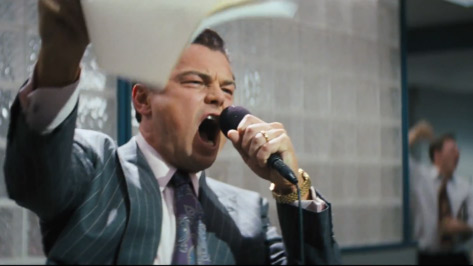
Scorsese, in depicting with great exuberance a sinner who, for his part, also describes his sins exuberantly, brings to light the mighty unconscious of humanity.
#Wolf of wall street movie ending movie
There are no innocents in Scorsese’s vision the movie is a unified field of dubious desire, of temptation, evil, and sin. To see Belfort’s victims, look in the mirror-and look there to see Belfort’s collaborators, too. Later, others are shown studying Belfort’s sales techniques in order to move from the ranks of the taken to those of the takers. Early on, some are heard on the phone, looking to make money through investments that they don’t earn (take seriously, after all, the lurid concept of “unearned income” and let he who has no 401(k) throw the first stone). The complaint is shortsighted: the victims are everywhere. Too much has been made of the movie’s lack of attention to Belfort’s victims. (Though they’re pretty fascinating-despite Belfort’s comic demurrals: the fraudster seems to have had as good a time concocting his schemes as he did profitting from them.) Rather, the movie is about the drives and urges, the pleasures and the self-indulgences, the power plays and manipulations, the ingratiations and deceptions, the allegiances and the compromises and the calculations on which human society runs-about life in this fallen world. Scorsese’s movie is hardly about Wall Street, even less about the specific mechanisms of Belfort’s financial fraud. The difference is that Scorsese’s vision is utterly unromantic: the ideal that he has in mind isn’t within the grasp of human endeavor. Just as the fictionalized Belfort (Leonardo DiCaprio) is presented at the seminar by a host (who, in a diabolical cameo, is played by the real-life Belfort), so we, the movie audience, have been introduced to Belfort by another enthusiastic impresario, namely Martin Scorsese, who knows perfectly well that he is giving us something that we want, something that we need, and something that taps into dreams and ambitions that are both central to life and completely suspect.Īs with the ending of Carl Theodor Dreyer’s “Gertrud” and John Ford’s “7 Women,” the end of “The Wolf of Wall Street” renounces a world of horrors even as it embraces its destructive passions. The shot shows not just an audience, but the audience: Scorsese puts the film’s viewers face to face with themselves, charges us with compensating for our lack of imagination and fatal ambition through contact with the wiles of a master manipulator. It’s a moment with a terrifying, Olympian blend of compassion, disdain, and anguish it shows a fatal lack of imagination combined with a desperate range of unfulfilled desires.

None of them has a clue, and Scorsese’s camera rises over their heads to scan the yearning, vacant faces of the aspirants in the rows behind them.

Belfort challenges those in the front row, one by one, to sell him a pen.

By now, there has been enough discussion for everyone to know that it shows an audience-attendees at a sales-technique seminar held by Jordan Belfort, in New Zealand, after his release from prison. Let’s start with that last shot, which I cited but remained coy about when writing about the movie before it opened. “The Wolf of Wall Street” is even more capacious.


 0 kommentar(er)
0 kommentar(er)
